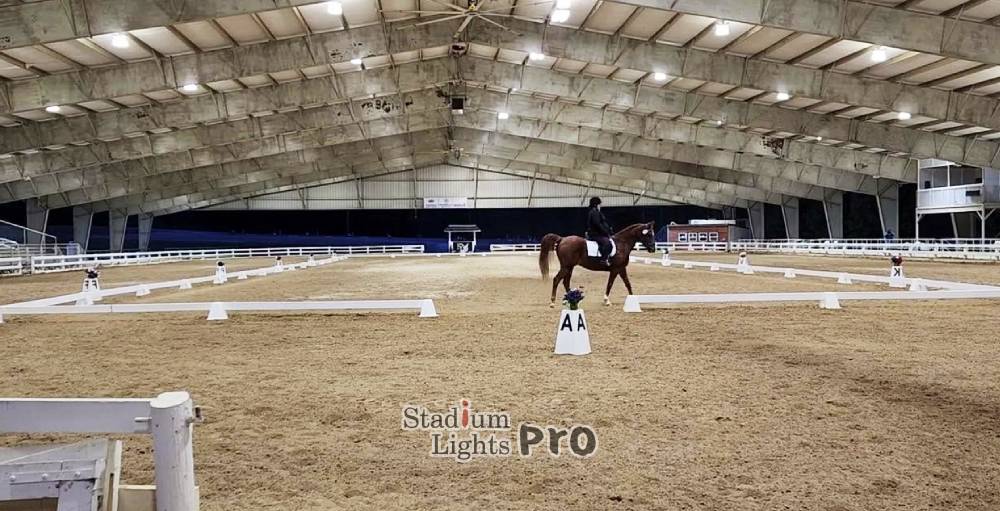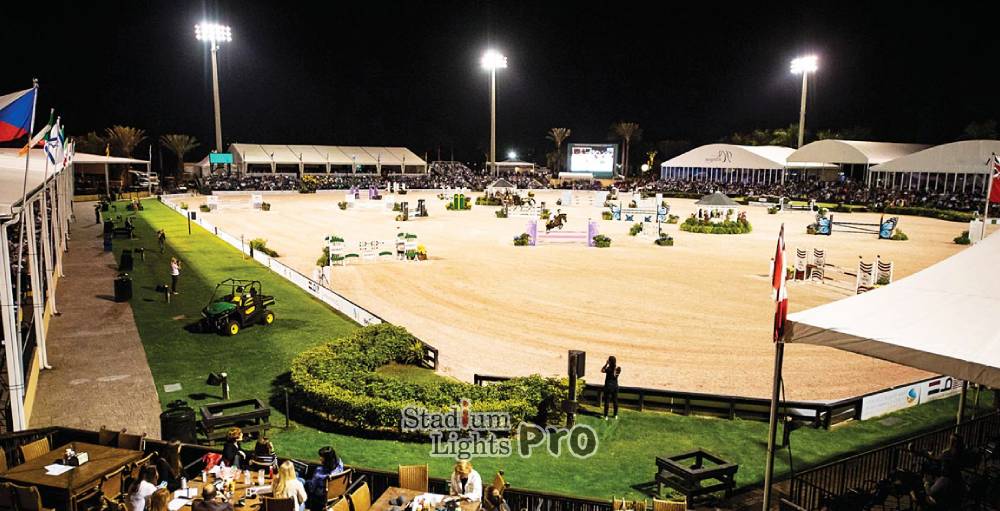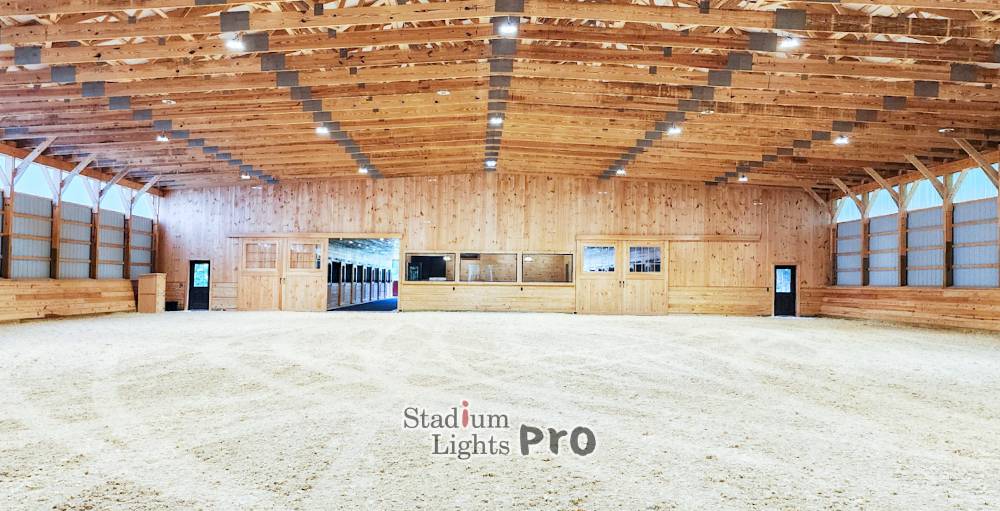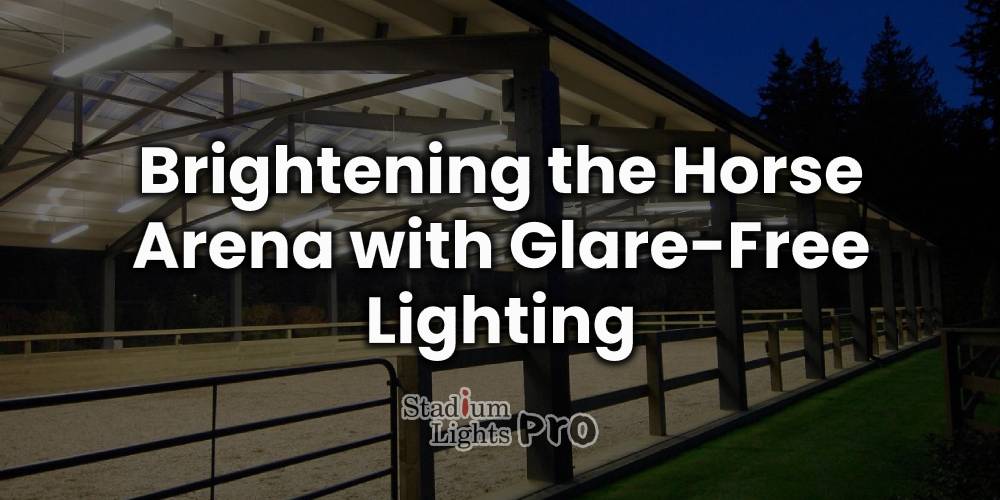Lighting plays a fundamental role in ensuring optimal visibility and performance in horse arenas. A well-lit arena can enhance the overall experience for both horses and riders, especially when training or competing at night. However, one of the most challenging aspects of arena lighting is dealing with glare. Glare can disrupt visibility, create discomfort, and reduce safety during activities. By choosing the right lighting solutions, glare can be minimized, ensuring a more enjoyable and safer environment for all participants.
Table of Contents
ToggleUnderstanding Glare in Horse Arenas

Glare is the discomfort caused by bright lights that lead to excessive contrast between the illuminated and darker areas. In horse arenas, glare can be caused by several factors, including poor light placement, intense lighting fixtures, and incorrect light distribution. When glare is present, it can distort the rider’s ability to see clearly, making it harder to guide the horse through maneuvers, while also compromising the safety of the horse and rider.
The Impact of Glare on Horse and Rider Performance
For both the rider and the horse, glare can be distracting and disorienting. Riders may struggle to maintain focus during critical moments of competition or training due to the harshness of bright lights. The horse, too, can become unsettled by sudden flashes or overly bright spots, affecting its behavior and performance. In turn, this can increase the risk of accidents or mistakes during rides. Therefore, achieving proper lighting without glare is a necessity for creating a smooth and efficient environment.
The Different Types of Glare
There are various forms of glare that can affect a horse arena. Direct glare occurs when light comes directly into the line of sight, such as from overhead lights that are too bright or improperly positioned. Indirect glare, on the other hand, happens when light reflects off surfaces like the arena floor, walls, or other elements. Both types can make it difficult for riders and horses to adjust to the lighting conditions, reducing the overall experience.
Choosing the Right Lighting Fixtures for Your Horse Arena

Selecting the right lighting fixtures is one of the most important steps when planning the illumination for a horse arena. The quality and placement of lighting can significantly influence the overall performance, safety, and comfort within the arena. With many different types of lighting solutions available, it is essential to understand which one best meets the needs of both the rider and the horse. LED lights have gained widespread popularity in equestrian arenas due to their energy efficiency, long lifespan, and ability to provide a consistent light output with minimal glare.
LED Lighting for Clear Visibility

LED lights have become the preferred option for horse arenas due to their many advantages over traditional lighting types such as halogen and fluorescent bulbs. One of the main benefits of LED lighting is its ability to produce an even, glare-free illumination across the entire arena. Unlike older lighting technologies that tend to cast intense, direct beams of light, often creating harsh spots and dark corners, LED lights are engineered to disperse light evenly. This reduces the occurrence of glare and ensures that both the horse and rider are able to see clearly in every corner of the arena, regardless of the time of day or night.
LED lights are also highly versatile. Their brightness can be adjusted as needed to match the specific requirements of the arena and the activities taking place. This dimming capability makes it easier to fine-tune the lighting balance and prevent overly bright conditions that could cause discomfort or hinder visibility. By reducing the chances of creating harsh lighting zones, LED lights not only offer superior clarity but also provide a more controlled and consistent lighting environment for the arena. The high efficiency of LED lights also means they consume less energy while delivering superior performance, reducing both operational costs and environmental impact over time.
Choosing the Right Wattage and Coverage
When selecting LED fixtures for your arena, the wattage and coverage of the lights play a major role in how effectively glare is minimized. Too much wattage can lead to an excessively bright environment, which can create intense glare, making it difficult for both the rider and the horse to see clearly. On the other hand, insufficient wattage results in dim lighting that creates shadows and uneven illumination. This can cause certain areas of the arena to be inadequately lit, further contributing to difficulties with visibility and potentially increasing the risk of accidents.
It is crucial to match the wattage of the lighting fixtures to the size of the arena. Larger arenas require more powerful fixtures to ensure that every area is adequately illuminated. Proper planning of the lighting layout is also essential to ensure that every corner of the arena receives sufficient light without generating harsh spots. Overpowering the arena with excessive wattage may result in discomfort, while insufficient wattage will lead to poor visibility. Therefore, achieving a balance in wattage is a key factor in reducing glare and ensuring that the arena remains both well-lit and comfortable for use.
For example, larger competition arenas typically need more powerful lights due to their vast size, while smaller arenas may require fewer lights with less wattage. Adjusting the number and placement of lights based on the arena’s size will allow for consistent coverage throughout the space without overwhelming the environment with unnecessary brightness.
Light Placement and Direction
The placement and direction of the lighting fixtures are just as important as the wattage in controlling glare and ensuring optimal visibility. One of the most common causes of glare in horse arenas is improper light positioning. Lights that are installed too high or that are not aimed correctly can cast harsh shadows, disrupt visibility, and create bright spots in certain areas. These lighting flaws can make it difficult for both riders and horses to adapt to their surroundings, particularly in competitions or high-speed training situations.
To minimize glare and ensure even coverage, lighting fixtures should be positioned at appropriate angles and heights. Lighting should be installed in a way that illuminates the arena evenly from all directions, while also avoiding direct exposure to the rider’s eyes. Direct light in the rider’s line of sight can create discomfort, making it hard to focus on riding or guiding the horse through maneuvers. It’s also important to angle the lights so that they are directed towards the arena floor, rather than toward the rider’s head or the horse’s face. This helps prevent excessive brightness from impairing vision while maintaining a balanced and comfortable level of illumination throughout the space.
When positioning the lights, careful attention should also be given to spacing. Lights placed too far apart can lead to uneven coverage and create areas of darkness. On the other hand, lights that are placed too close together can create overly bright zones and lead to glare. To achieve consistent illumination, fixtures should be spaced out evenly, ensuring that the light is distributed uniformly across the entire arena. Proper spacing and direction will also ensure that no area is left in shadow, providing a clear and safe environment for both riders and horses to work in.
By taking these factors into account, you can create a well-lit, glare-free arena that provides consistent, comfortable lighting for every rider and horse that uses the space. Thoughtful planning of wattage, light placement, and direction will help eliminate the risk of glare while maximizing visibility, ensuring a safe and enjoyable experience for all.
Factors to Consider for Glare-Free Arena Lighting
When planning the lighting system for a horse arena, several factors need to be considered to achieve a glare-free environment. These include the size of the arena, the type of activities taking place, and the positioning of the lights.
Arena Size and Shape
The size and shape of the arena will determine the amount and distribution of light required. Larger arenas may require more lights, placed at strategic intervals to ensure even coverage throughout the space. Smaller arenas may need fewer lights but still require thoughtful placement to avoid creating bright spots or shadows. By considering the dimensions of the arena, a lighting plan can be tailored to meet the unique needs of the space.
The Purpose of the Arena
Different activities may require different lighting setups. For example, arenas used for casual riding or training may not need as intense lighting as those used for competitions. Competition arenas demand more precise, evenly distributed lighting to ensure every movement is visible, while a simple training arena might focus on basic visibility with minimal glare. Identifying the primary use of the arena can help guide decisions on the type and intensity of the lighting.
The Surrounding Environment
The surrounding environment, such as the outdoor location of the arena or the presence of surrounding structures, can also influence glare management. If an arena is situated outdoors, factors like ambient light, nearby streetlights, and natural elements like trees can affect the way lighting behaves. These variables must be taken into account when designing the lighting layout to ensure glare is controlled and visibility is maximized.
The Role of Lighting Accessories in Glare Reduction
While selecting the right lighting fixtures is crucial for creating a glare-free environment, incorporating specific lighting accessories can further enhance the overall lighting experience in a horse arena. Accessories such as diffusers, reflectors, and louvered fixtures play a key role in minimizing glare and ensuring a smooth, comfortable lighting experience for both horses and riders.
Diffusers and Reflectors
Diffusers and reflectors are commonly used in conjunction with lighting fixtures to improve light distribution and reduce glare. A diffuser is designed to scatter light across a broader area, which helps to soften the intensity of direct light. By dispersing light more evenly, diffusers prevent the creation of harsh bright spots that can lead to discomfort and visual distractions. This helps to create a more uniform lighting environment, enhancing visibility and reducing the chances of glare.
Reflectors, on the other hand, are designed to redirect the light produced by the fixtures in specific directions. Rather than allowing light to spill in uncontrolled patterns, reflectors direct light precisely where it is needed, ensuring even coverage throughout the arena. The use of reflectors can also help prevent light from spilling over into areas where it is not needed, minimizing unwanted brightness and reducing glare. Both diffusers and reflectors work together to create a smooth, uninterrupted flow of light that enhances the arena’s overall visibility, comfort, and safety for both the horse and the rider.
Louvered Fixtures
Louvered fixtures are another highly effective tool for reducing glare in a horse arena. These fixtures are designed to shield the light source, controlling the direction of light and minimizing direct exposure to the eyes. Louvered fixtures consist of slatted panels that allow light to pass through in controlled patterns while preventing it from shining directly into the line of sight. This shielding effect helps to create a more comfortable and visually balanced environment, as it reduces the harshness of direct light and ensures that only the necessary areas are illuminated.
In a horse arena, where riders and horses need to maintain focus on their movements, the use of louvered fixtures can make a noticeable difference. By minimizing direct exposure to bright lights, louvered fixtures reduce the likelihood of discomfort and visual strain, which can otherwise impair performance. With their ability to direct light to the appropriate areas while protecting the eyes from intense glare, louvered fixtures contribute to both rider comfort and safety.
Moreover, these fixtures can also help to improve the overall aesthetic of the arena. The design of louvered fixtures not only enhances functionality but can also complement the architectural style of the arena, making them a practical and visually appealing addition to the lighting setup.
The Benefits of Glare-Free Lighting for Horse Arenas
The advantages of glare-free lighting extend beyond simply improving visibility. They contribute to a more comfortable and safer environment for horses and riders, enhancing both training and competition experiences.
Improved Rider Focus and Comfort
Without glare interfering with visibility, riders can maintain better focus and control over their movements. The absence of harsh lighting allows riders to stay engaged with their surroundings without distractions. This leads to smoother rides and more accurate maneuvers, whether in training or competition. Riders will also experience less strain on their eyes, reducing discomfort during long sessions.
Enhanced Horse Comfort and Safety
Glare-free lighting also creates a more comfortable environment for horses. Horses are sensitive to sudden changes in light, and bright spots or harsh shadows can make them anxious or reactive. By providing an even, glare-free light, horses will feel more secure, which is vital for their performance and safety. Horses are less likely to be startled by flashes of bright light, leading to more consistent behavior.
Better Visibility and Safety for All Participants
When glare is eliminated, both riders and spectators can enjoy better visibility. Whether watching from the sidelines or actively participating, all individuals involved in the arena experience enhanced safety. Clearer visibility reduces the chances of accidents occurring, allowing for safer interactions between horse, rider, and onlookers.
Maximizing Arena Lighting Efficiency
Beyond reducing glare, making the most of your arena’s lighting system involves considering energy efficiency and sustainability. Using energy-efficient lighting like LEDs helps minimize energy consumption while providing consistent, high-quality illumination. Additionally, integrating smart lighting controls, such as motion sensors or timers, can further reduce energy waste and optimize the lighting experience based on the time of day and the activities taking place.
By taking a thoughtful approach to the lighting setup, considering all factors from fixture type to placement, glare can be minimized, creating a harmonious and effective environment for training and competition.
Conclusion
Incorporating glare-free lighting into a horse arena transforms the space into a safer and more enjoyable environment for both horses and riders. By carefully selecting the right fixtures, considering proper light placement, and using accessories like diffusers and reflectors, it’s possible to achieve even, comfortable lighting that enhances performance and minimizes distractions. A well-lit arena not only boosts visibility but also contributes to better focus, reduces discomfort, and promotes safety. With the right approach to lighting design, the arena becomes a place where both horse and rider can perform at their best, day or night.

